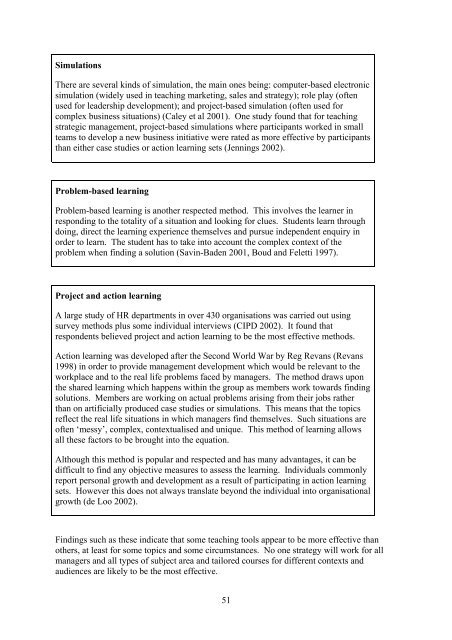The Development of Management and Leadership Capability and its ...
The Development of Management and Leadership Capability and its ...
The Development of Management and Leadership Capability and its ...
Create successful ePaper yourself
Turn your PDF publications into a flip-book with our unique Google optimized e-Paper software.
Simulations<br />
<strong>The</strong>re are several kinds <strong>of</strong> simulation, the main ones being: computer-based electronic<br />
simulation (widely used in teaching marketing, sales <strong>and</strong> strategy); role play (<strong>of</strong>ten<br />
used for leadership development); <strong>and</strong> project-based simulation (<strong>of</strong>ten used for<br />
complex business situations) (Caley et al 2001). One study found that for teaching<br />
strategic management, project-based simulations where participants worked in small<br />
teams to develop a new business initiative were rated as more effective by participants<br />
than either case studies or action learning sets (Jennings 2002).<br />
Problem-based learning<br />
Problem-based learning is another respected method. This involves the learner in<br />
responding to the totality <strong>of</strong> a situation <strong>and</strong> looking for clues. Students learn through<br />
doing, direct the learning experience themselves <strong>and</strong> pursue independent enquiry in<br />
order to learn. <strong>The</strong> student has to take into account the complex context <strong>of</strong> the<br />
problem when finding a solution (Savin-Baden 2001, Boud <strong>and</strong> Feletti 1997).<br />
Project <strong>and</strong> action learning<br />
A large study <strong>of</strong> HR departments in over 430 organisations was carried out using<br />
survey methods plus some individual interviews (CIPD 2002). It found that<br />
respondents believed project <strong>and</strong> action learning to be the most effective methods.<br />
Action learning was developed after the Second World War by Reg Revans (Revans<br />
1998) in order to provide management development which would be relevant to the<br />
workplace <strong>and</strong> to the real life problems faced by managers. <strong>The</strong> method draws upon<br />
the shared learning which happens within the group as members work towards finding<br />
solutions. Members are working on actual problems arising from their jobs rather<br />
than on artificially produced case studies or simulations. This means that the topics<br />
reflect the real life situations in which managers find themselves. Such situations are<br />
<strong>of</strong>ten ‘messy’, complex, contextualised <strong>and</strong> unique. This method <strong>of</strong> learning allows<br />
all these factors to be brought into the equation.<br />
Although this method is popular <strong>and</strong> respected <strong>and</strong> has many advantages, it can be<br />
difficult to find any objective measures to assess the learning. Individuals commonly<br />
report personal growth <strong>and</strong> development as a result <strong>of</strong> participating in action learning<br />
sets. However this does not always translate beyond the individual into organisational<br />
growth (de Loo 2002).<br />
Findings such as these indicate that some teaching tools appear to be more effective than<br />
others, at least for some topics <strong>and</strong> some circumstances. No one strategy will work for all<br />
managers <strong>and</strong> all types <strong>of</strong> subject area <strong>and</strong> tailored courses for different contexts <strong>and</strong><br />
audiences are likely to be the most effective.<br />
51
















